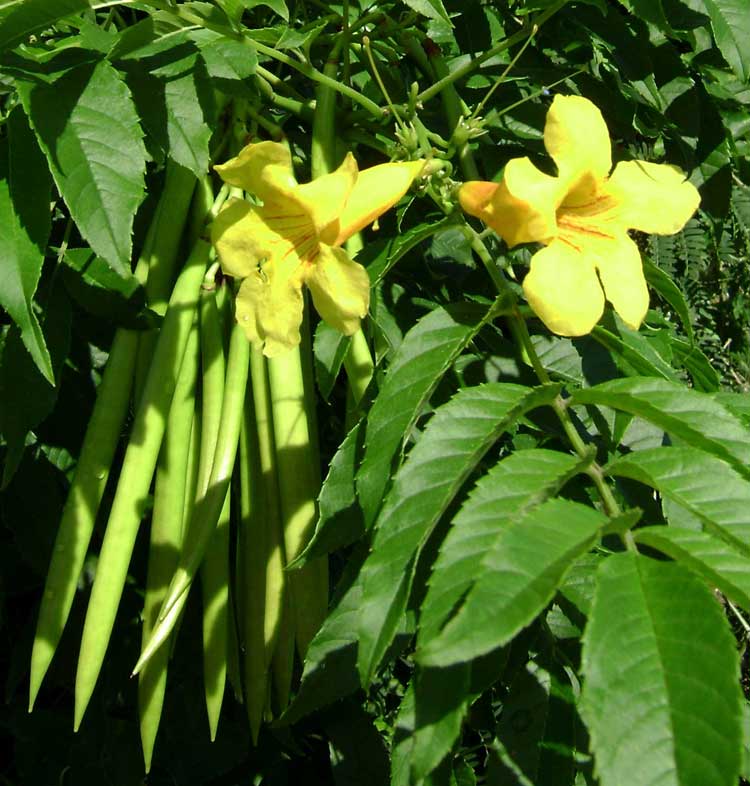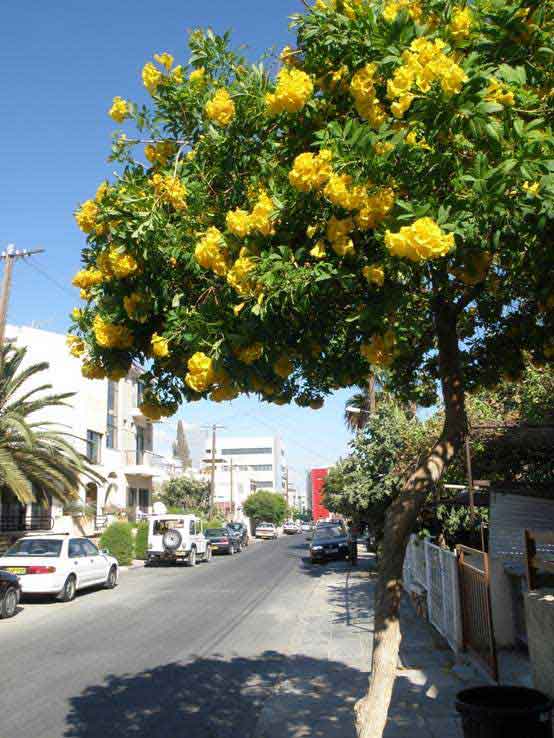
Yellow Trumpetbush (Tecoma stans), (*)
Classification System: APG IV
Superregnum: Eukaryota
Regnum: Plantae
Cladus: Angiosperms
Cladus: Eudicots
Cladus: Core eudicots
Cladus: Asterids
Cladus: Lamiids
Ordo: Lamiales
Familia: Bignoniaceae
Tribus: Tecomeae
Genus: Tecoma
Species: Tecoma stans
Varietates: T. s. var. angustata – T. s. var. sambucifolia – T. s. var. stans – T. s. var. velutina
Name
Tecoma stans (L.) Juss. ex Kunth
Synonyms
Basionym
Bignonia stans L., Sp. Pl. ed. 2: 871 (1763).
Homotypic
Stenolobium stans (L.) Seem., J. Bot. 1: 88. (1863).
Gelseminum stans (L.) Kuntze, Revis. Gen. Pl. 2: 479 (1891).
Distribution
Native distribution areas:
Continental: Northern America
USA (Arizona, Florida, New Mexico, Texas)
Continental: Southern America
Bahamas, Turks & Caicos Isl., Cayman Isl., Cuba, Hispaniola, Jamaica, Puerto Rico, Virgin Isl. (Jost van Dyke, St. Croix, St. John, St. Thomas, Tortola, Virgin Gorda), Lesser Antilles (Anguilla, Antigua, Barbados, Dominica, Grenada, Grenadines, Guadeloupe, Martinique, Montserrat, Saba, St. Barthelemy, St. Eustatius, St. Kitts, St. Lucia, St. Martin, St. Vincent), Curacao, Isla Margarita, Trinidad, Tobago, Mexico (Aguascalientes, Baja California Sur, Campeche, Chiapas, Chihuahua, Coahuila, Colima, Ciudad de Mexico, Durango, Guanajuato, Guerrero, Hidalgo, Jalisco, Mexico State, Michoacan, Morelos, Nayarit, Nuevo Leon, Oaxaca, Puebla, Queretaro, Quintana Roo, San Luis Potosi, Sinaloa, Sonora, Tabasco, Tamaulipas, Tlaxcala, Veracruz, Yucatan, Zacatecas), Belize (I), Guatemala, El Salvador, Honduras, Nicaragua, Costa Rica, Panama, Colombia (Amazonas, Antioquia, Atlntico, Bolvar, Boyac, Cauca, Cundinamarca, Huila, Magdalena, Nario, Quindo, Santander, Tolima, Valle), Venezuela (Aragua, Carabobo, Delta Amacuro, Distrito Federal, Falcon, Guarico, Lara, Merida, Miranda, Monagas, Nueva Esparta, Sucre, Tachira, Zulia), WC-Brazil (Mato Grosso, Goias, Distrito Federal, Mato Grosso do Sul), SE-Brazil (Minas Gerais, Espirito Santo, Sao Paulo, Rio de Janeiro), Peru, Ecuador, Bolivia (Beni, Chuquisaca, Cochabamba, La Paz, Santa Cruz, Tarija), Argentina (Catamarca, Corrientes, Entre Rios, Jujuy, Misiones, Salta, Santiago del Estero, Santa Fe, Tucuman), S-Brazil (Rio Grande do Sul), Paraguay (Central)
References: Brummitt, R.K. 2001. TDWG – World Geographical Scheme for Recording Plant Distributions, 2nd Edition

Yellow Trumpetbush (Tecoma stans), Mesa Geitonia, Photo : Augusta Stylianou Artist
References
Palisot de Beauvois, A.M.F.J. in F. W. H. A. von Humboldt et al., 1819. Nov. Gen. Sp. Pl. 3: 112 [folio]; 3: 144 [quarto]. 1819 (A. L. Jussieu, Gen. pl. t. 139. 1789, comb. not made)
Gentry, A. H. 1992. Flora Neotropica 25 (2): 285 (lectotypification as illustration in Plumier, Plantae Americanae t. LIV, 1756; type locality "Haiti(?)").
Links
Govaerts, R. et al. 2019. Tecoma stans in World Checklist of Selected Plant Families. The Board of Trustees of the Royal Botanic Gardens, Kew. Published on the internet. Accessed: 2019 May 03. Reference page.
Hassler, M. 2019. Tecoma stans. World Plants: Synonymic Checklists of the Vascular Plants of the World In: Roskovh, Y., Abucay, L., Orrell, T., Nicolson, D., Bailly, N., Kirk, P., Bourgoin, T., DeWalt, R.E., Decock, W., De Wever, A., Nieukerken, E. van, Zarucchi, J. & Penev, L., eds. 2019. Species 2000 & ITIS Catalogue of Life. Published on the internet. Accessed: 2019 May 03. Reference page.
International Plant Names Index. 2019. Tecoma stans. Published online. Accessed: May 03 2019.
The Plant List 2013. Tecoma stans in The Plant List Version 1.1. Published on the internet. Accessed: 2019 May 03.
Tropicos.org 2019. Tecoma stans. Missouri Botanical Garden. Published on the internet. Accessed: 2019 May 03.
USDA, ARS, Germplasm Resources Information Network. Tecoma stans in the Germplasm Resources Information Network (GRIN), U.S. Department of Agriculture Agricultural Research Service. Accessed: 07-Oct-06.
Vernacular names
čeština: Tekoma vzpřímená
Deutsch: Gelbe Trompetenblume
English: Yellow Trumpetbush
español: Tronadora
suomi: Keltatekoma
polski: Tekoma prosta
português: Ipê-de-jardim
Runa Simi: Sawsaw
русский: Текома прямостоячая
svenska: Gul trumpetbuske
lea faka-Tonga: Piti
reo tahiti: Piti
Tecoma stans is a species of flowering perennial shrub in the trumpet vine family, Bignoniaceae, that is native to the Americas. Common names include yellow trumpetbush,[2] yellow bells,[2] yellow elder,[2] ginger-thomas. Tecoma stans is the official flower of the United States Virgin Islands and the floral emblem of The Bahamas.
Description
Flowers
A semi-evergreen shrub that can grow to a small tree, it features sharply toothed, opposite green leaves that are pinnate unpaired, with 3 to 13 serrate, 8 to 10 cm long leaflets. The leaflets, glabrous on both sides, have an elliptical lanceolate blade 2-10 cm long and 1-4 cm wide, with a long acuminate apex and a wedge-shaped base. The margin is finely toothed It reaches heights of 6 to 9 meters.
The large, showy, golden yellow, trumpet-shaped flowers are in clusters at the branch ends, are bell-shaped-funnel-shaped, five-lobed (with weakly two-lipped), often reddish-veined in the throat and 3.5 to 8.5 cm long. Flowering takes place all year round. The fruits arise from two carpels and are up to 25 cm long, narrow capsules. The flowers attract bees, butterflies, and hummingbirds.[3] The plant produces pods containing yellow seeds with papery wings. They release many seeds with membranous wings when they open. Tecoma stans reproduces sexually (by anemochory) or asexually.
Habitat
Tecoma stans is native to the Americas. It extends from the southern United States through Mexico, Central America, and the Antilles to northern Venezuela, and through the Andes mountain range to northern Argentina. It was introduced in southern Africa and Hawaii
Yellow trumpetbush is a ruderal species, readily colonizing disturbed, rocky, sandy, and cleared land and occasionally becoming an invasive weed. It thrives in a wide variety of ecosystems, from high altitude temperate forests and tropical deciduous and evergreen forests, to xerophilous scrub and the intertropical littoral. It quickly colonizes disturbed, rocky, sandy, and cleared fields. The species prefers dry and sunny regions of the coast.
Cultivation
Esperanza is drought-tolerant and grows well in warm climates. It is an attractive plant that is cultivated as an ornamental. They are grown in many parts of the world for their beautiful flowering, to adorn streets and gardens. The wood is used in rustic architecture like bahareque, for the construction of furniture and canoes, or as firewood or charcoal. It is a medicinal plant used against diabetes and against diseases of the digestive system, among other uses. The plant is desirable fodder when it grows in fields grazed by livestock.
Invasiveness
It has invasive potential and occasionally becomes a weed. The species is considered invasive in Africa (especially South Africa), South America, Asia, Australia and the Pacific Islands. It now presents a significant danger for biodiversity. It competes with local species and can form thick, almost monospecific thickets.
References
theplantlist.org
"Tecoma stans". Germplasm Resources Information Network (GRIN). Agricultural Research Service (ARS), United States Department of Agriculture (USDA). Retrieved 22 December 2017.
For example the sapphire-spangled emerald (Amazilia lactea) in Brazil (Baza Mendonça & dos Anjos 2005)
Retrieved from "http://en.wikipedia.org/"
All text is available under the terms of the GNU Free Documentation License

